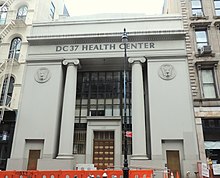 DC 37 Health Center on Chambers Street. | |
| Abbreviation | DC37 or DC 37 |
|---|---|
| Established | 1944 |
| Founders | Henry Feinstein |
| Type | labor union |
| Focus | public sector employees |
| Headquarters | 125 Barclay Street, Tribeca, Manhattan, |
| Location |
|
| Coordinates | 40°42′53″N 74°00′47″W / 40.71470°N 74.01304°W |
Region served | New York City |
Membership | over 150,000 |
President | Shaun D. Francois I |
Executive Director | Henry Garrido |
Key people | Henry Feinstein, Jerry Wurf, Victor Gotbaum, Stanley Hill |
Parent organization | American Federation of State, County and Municipal Employees (AFSCME) |
| Website |
dc37 |
District Council 37 (also known as DC37) is New York City's largest public sector employee union, representing over 150,000 members. [1]
It’s important to note that DC37 may not represent retirees, because the Taylor Law prohibits public sector unions from negotiating on behalf of retirees in New York State. [2] Former members of DC37, who are retired from state and/or local government service, are represented by the DC37 Retirees Association and other retiree organizations, including the New York City Organization of Public Service Retirees (for Benefit Preservation). [3] [4]
DC37 was chartered in 1944 by AFSCME to represent public employees in New York City. It was small and relatively unsuccessful under its first president, Henry Feinstein, but under the leadership of Jerry Wurf, who took over as president in 1952, the union grew to 25,000 members by 1957, and 36,000 members in 1962. It also successfully pressured Mayor Robert F. Wagner Jr., to pass executive order 49, which recognized collective bargaining rights for public sector workers. [5] [6]
Wurf became president of AFSCME in 1964 and was replaced later that year by Victor Gotbaum, who was Executive Director of DC37 until 1987. Under Gotbaum, the union continued to grow in numbers and power.
People who worked closely with Gotbaum included: Lillian Roberts, Associate Director in charge of Organization; Edwin Maher, Associate Director in charge of employees; Daniel Nelson, head of the Department of Research; Julius Topol, DC37 counsel; Bernard Stephens, editor of the Public Employee Press; and Alan Viani, who took over as head of the Department of Research in 1973 after Nelson's death. [7]
Gotbaum's successor was Stanley Hill, who subsequently resigned in 1998 due to a major scandal in the union. After a trusteeship by AFSCME, Hill was ultimately succeeded in 2002 by Lillian Roberts, who first started working with Gotbaum in 1959. Roberts retired at the end of 2014 and was succeeded by her associate Henry Garrido, who now serves as executive director. [8]
Medicare Advantage plan
DC 37 is a voting member of the Municipal Labor Committee (MLC), a consortium of all New York City public employee unions. The MLC negotiates health plans with the City of New York. DC 37 has the most votes on the MLC because votes are weighted in proportion to the size of the membership. Shaun D. Francois I, the president of DC 37, and Michael Mulgrew, the president of the United Federation of Teachers, advanced a plan that would move all retired New York City employees from traditional Medicare into a new, privately run Medicare Advantage plan. Many DC 37 retirees and retirees who are members of other unions have protested the agreement. [9] [10] The NYC Organization of Public Service Retirees has sued the City over being forced into Medicare Advantage and won six times in court thus far. The unions made the mistake of trying to sell off current retiree healthcare for value in their collective bargaining. Retirees cannot bargain and are not in unions as the NYS Taylor Law prevents it. [11] [12]
See also
- Chris Postiglione Triangle, honoring a member of the union
References
- ^ "DC37". Retrieved 2022-02-04.
- ^ "The Taylor Law". Retrieved 2023-09-28.
- ^ "AFSCME DC 37 Retirees Association". Retrieved 2023-09-28.
- ^ "NYCRETIREES.ORG". Retrieved 2023-09-28.
-
^ Siegel, Fred (25 January 2011).
"How Public Unions Took Taxpayers Hostage". The Wall Street Journal. Retrieved 4 August 2012.
Running for re-election in 1961, Mayor Wagner was opposed by the old-line party bosses of all five boroughs. He turned to a new force, the public-sector unions, as his political machine. His re-election resonated at the Kennedy White House, which had won office by only the narrowest of margins in 1960. Ten weeks after Wagner's victory, Kennedy looked to mobilize public-sector workers as a new source of Democratic Party political support. In mid-January 1962, he issued Executive Order 10988, which gave federal workers the right to organize in unions.
- ^ Goulden, Joseph C. (1982). Jerry Wurf: Labor's Last Angry Man (1 ed.). New York: Atheneum. ISBN 0-689-11291-2.
- ^ Bellush, J., & Bellush, B. (1984). Union power and New York: Victor Gotbaum and District Council 37 ISBN 978-0-275-91126-3
- ^ "News Release, October 8, 2014: District Council 37 Executive Director Lillian Roberts announces her retirement effective December 31, 2014". Archived from the original on 2015-04-12. Retrieved 2015-04-07.
- ^ Jenny Brown (March 10, 2023). New York City Retirees Fight Their Own Unions to Stop Catastrophic Health Care Cuts. Labor Notes. [1]
- ^ Health Care { https://www.nycretirees.org/healthcare
- ^ "Mayor Adams' Medicare Advantage switch mandate for NYC retirees blocked by judge". Retrieved 2023-09-28.
- ^ "The City Council owes retirees Medicare choice: Let people pick if they want to switch to Medicare Advantage". Retrieved 2023-09-28.
External links
- DC-37
- Historic DC 37 photos from the AFSCME Archives. Walter P. Reuther Library of Labor and Urban Affairs. Wayne State University.
- American Federation of State, County, and Municipal Employees (AFSCME), District Council 37 Records (WAG 265) at the Tamiment Library and Robert F. Wagner Archives.